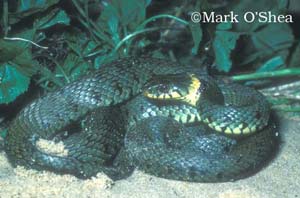Check out the English grass snake.
Distribution: British Isles to western Asia.
Habitat: Water meadows, lakes and pools, grassland and gardens with ponds and compost heaps.
Diet: Frogs, toads, newts and occasionally fish.
Max. length: 850-1200mm SVL (1200-1800mm TL).
Reproductive strategy: Oviparous with clutches of 5-30 eggs.
Eleven subspecies of grass snakes are recognized, the subspecies occurring in the British Isles (not Ireland), France and northern Italy being known as Natrix natrix helvetica. However, the central Italian populations, from which specimens imported into the UK as pets in the 1960s were probably drawn, is now separated from N.n.helvetica as N.n.lanzai. Grass snakes do not do well in captivity, although, the Italian specimens could at least be convinced to feed, unlike their British counterparts. The typical English grass snake has a yellow and black colour behind its head but this may be obscured or indistinct in some populations.

Mark O'Shea
English Grass Snake
Sources for more information:
Appleby L.G. 1971, British Snakes. John Baker. xiv+150pp.
Arnold E.N. & J.A. Burton 1978, A Field Guide to the Reptiles and Amphibians of Britain and Europe. Collins. 272pp.
Beebee T. & R. Griffiths 2000, Amphibians and Reptiles: A Natural History of the British Herpetofauna. Harper-Collins New Naturalist. 270pp.
Bell T. 1849, British Reptiles. xxiv+159pp.
Frazer D. 1983, The New Naturalist: Reptiles and Amphibians in Britain. Collins. 256pp.
Leighton G.R. 1901, British Serpents. W.Blackwood & Sons. xvi+383pp.
Steward J.W.1971, The Snakes of Europe. David & Charles. 238pp.
Street D. 1979, Reptiles of Northern and Central Europe. Batsford. xi+268pp.
Thorpe R. 1980, Microevolution and taxonomy of European reptiles with particular reference to the grass snake Natrix natrix and the wall lizards Podarcis sicula and P.melisellensis. Biological Journal of the Linnean Society 14(2):215-233.


